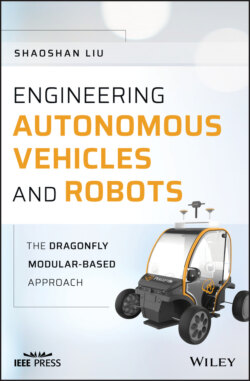Читать книгу Engineering Autonomous Vehicles and Robots - Shaoshan Liu - Страница 15
1.3.1 Sensor Fusion
ОглавлениеUsing LiDAR for localization or perception is extremely expensive and may not be reliable. To achieve affordability and reliability, multiple affordable sensors (cameras, GNSS receivers, wheel encoders, radars, and sonars) can be used to synergistically fuse their data. Not only do these sensors each have their own characteristics, drawbacks, and advantages but they complement each other such that when one fails or otherwise malfunctions, others can immediately take over to ensure system reliability. With this sensor fusion approach, sensor costs are limited to under $2000.
The localization subsystem relies on GNSS receivers to provide an initial localization with sub-meter-level accuracy. Visual odometry can further improve the localization accuracy down to the decimeter level. In addition, wheel encoders can be used to track the vehicles' movements in case of GNSS receiver and camera failures. Note that visual odometry deduces position changes by examining the overlaps between two frames. However, when a sudden motion is applied to the vehicle, such as a sharp turn, it is possible that visual odometry will fail to maintain localization due to the lack of overlapping regions between two consecutive frames.
The active perception subsystem seeks to assist the vehicle in understanding its environment. Based on this understanding and a combination of computer vision and of millimeter wave (mmWave) radars to detect and track static or moving objects within a 50 m range, the vehicle can make action decisions to ensure a smooth and safe trip. With stereo vision, not only can objects including pedestrians and moving vehicles be easily recognized but the distance to these detected objects can be accurately pinpointed as well. In addition, mmWave radars can also detect and track fast-moving objects and their distances under all weather conditions.
The passive perception subsystem aims to detect any immediate danger and acts as the last line of defense of the vehicle. It covers the near field, i.e. a range of 0–5 m around the vehicle. This is achieved by a combination of mmWave radars and sonars. Radars are very good moving object detectors and sonars are very good static object detectors. Depending on the current vehicle speed, when something is detected within the near field, different policies are put into place to ensure the safety of the vehicle.
